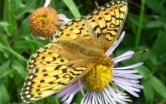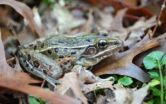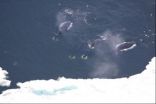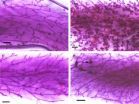(Press-News.org) Early snowmelt caused by climate change in the Colorado Rocky Mountains snowballs into two chains of events: a decrease in the number of flowers, which, in turn, decreases available nectar. The result is decline in a population of the Mormon Fritillary butterfly, Speyeria mormonia.
Using long-term data on date of snowmelt, butterfly population sizes and flower numbers at the Rocky Mountain Biological Laboratory, Carol Boggs, a biologist at Stanford University, and colleagues uncovered multiple effects of early snowmelt on the growth rate of an insect population.
"Predicting effects of climate change on organisms' population sizes will be difficult in some cases due to lack of knowledge of the species' biology," said Boggs, lead author of a paper reporting the results online in this week's journal Ecology Letters.
Taking into account the butterfly's life cycle and the factors determining egg production was important to the research.
Butterflies lay eggs (then die) in their first summer; the caterpillars from those eggs over-winter without eating and develop into adults in the second summer.
In laboratory experiments, the amount of nectar a female butterfly ate determined the number of eggs she laid. This suggested that flower availability might be important to changes in population size.
Early snowmelt in the first year leads to lower availability of the butterfly's preferred flower species, a result of newly developing plants being exposed to early-season frosts that kill flower buds.
The ecologists showed that reduced flower--and therefore nectar--availability per butterfly adversely affected butterfly population growth rate.
Early snowmelt in the second year of the butterfly life cycle worsened the effect, probably through direct killing of caterpillars during early-season frosts.
The combined effects of snowmelt in the two consecutive years explained more than four-fifths of the variation in population growth rate.
"Because species in natural communities are interconnected, the effects of climate change on any single species can easily be underestimated," said Saran Twombly, program director in the National Science Foundation's Division of Environmental Biology, which funded the research.
"This study combines long-term, data models, and an understanding of species interactions to underscore the complex effects climate change has on natural populations."
"It's very unusual for research to uncover a simple mechanism that can explain almost all the variation in growth rate of an insect population," said David Inouye, a biologist at the University of Maryland and co-author of the paper.
Indeed, "one climate parameter can have multiple effects on an organism's population growth," Boggs said. "This was previously not recognized for species such as butterflies that live for only one year.
"We can already predict that this coming summer will be a difficult one for the butterflies," she said, "because the very low snowpack in the mountains this winter makes it likely that there will be significant frost damage."
"Long-term studies such as ours are important to understanding the 'ecology of place,' and the effects of weather and possible climate change on population numbers," said Inouye.
"This research is critical to assessing the broader effects of weather on an ever-changing Earth," he said. "By facilitating long-term studies, field stations such as the Rocky Mountain Biological Laboratory are an invaluable asset."
INFORMATION:
Stanford University's Vice Provost for Undergraduate Education also funded the work.
Early spring drives butterfly population declines
'Ahead-of-time' snowmelt triggers chains of events in the Mormon Fritillary butterfly
2012-03-19
ELSE PRESS RELEASES FROM THIS DATE:
Hiding in plain sight, new frog species found in New York City
2012-03-19
In the wilds of New York City--or as wild as you can get that close to skyscrapers--scientists have found a new leopard frog species.
For years, biologists mistook it for a more widespread variety of leopard frog.
While biologists regularly discover new species in remote rainforests, finding this one in ponds and marshes--sometimes within view of the Statue of Liberty--is a big surprise, said scientists from the University of California, Los Angeles; Rutgers University; the University of California, Davis and the University of Alabama.
"For a new species to go unrecognized ...
Checking off symptoms online affects our perceptions of risk
2012-03-19
You've been feeling under the weather. You Google your symptoms. A half-hour later, you're convinced it's nothing serious—or afraid you have cancer. More than 60 percent of Americans get their health information online, and a majority of those decide whether to see a doctor based on what they find. "Wow, this is an era of self-diagnosis," thought Arizona State University psychologist Virginia Kwan, learning that statistic. How might information accessed online affect individual health decisions?
In a new study, Kwan and her colleagues found that the way information is ...
Researchers uncover molecular pathway through which common yeast becomes fungal pathogen
2012-03-19
TORONTO, ON—Scientists at the University of Toronto have found a molecular mechanism that plays a key role in the transition of Candida albicans yeast into disease-causing fungus—one of the leading causes of hospital-acquired infection. The finding highlights the importance of heat in fungal growth, and provides a new target for drug therapies to counter Candida albicans infection.
Candida albicans is a normally harmless yeast that is present in all humans. It becomes infectious in various genetic and environmental conditions, with temperature as a key determinant. It ...
Increase in Arctic shipping poses risk to marine mammals
2012-03-19
NEW YORK (March 16, 2012)—A rapid increase in shipping in the formerly ice-choked waterways of the Arctic poses a significant increase in risk to the region's marine mammals and the local communities that rely on them for food security and cultural identity, according to an Alaska Native groups and the Wildlife Conservation Society who convened at a recent workshop.
The workshop—which ran from March 12-14—examined the potential impacts to the region's wildlife and highlighted priorities for future management of shipping in the region. The meeting included participants ...
Glacier-fed river systems threatened by climate change
2012-03-19
Glacial meltwater increases biodiversity in mountainous freshwater ecosystems. As glaciers vanish due to global warming, so will those species dependent upon the icy runoff. This is the conclusion of a study authored by researchers from, among other institutions, the University of Copenhagen.
The article "Glacial river biodiversity" with the alarming new findings can be found in the journal Nature Climate Change.
"The knowledge is new and startling. Glacial runoff is cold, nutrient-poor and physically unstable, and therefore, typically species-poor. Traditionally, we ...
Researchers print live cells with a standard inkjet printer
2012-03-19
Researchers from Clemson University have found a way to create temporary holes in the membranes of live cells using a standard inkjet printer. The method will be published in JoVE, the Journal of Visualized Experiments, on March 16.
"We first had the idea for this method when we wanted to be able to visualize changes in the cytoskeleton arrangement due to applied forces on cells," said paper-author Dr. Delphine Dean.
She said other researchers have been using this method to print cells onto slides, but that they have only recently discovered that printing the cells ...
Study determines critical skills for PCPs to safely manage opioid risk in chronic pain patients
2012-03-19
The study's objective was to identify which skills and competencies are considered most critical for primary care providers (PCPs) to learn in order to effectively manage opioid risk in patients treated for chronic pain
Study participants included experts in primary care, pain management, and addiction
Experts in this study identified the most important skills for PCPs managing opioid risk in chronic pain patients as how to monitor opioids and how to assess for risk factors
Primary care physicians are faced with treating a large proportion of chronic pain patients, ...
Building the European Union's Natura 2000 -- the largest ever network of protected areas
2012-03-19
The European Union's Habitats Directive is now 20 years old, and its network of protected areas, known as Natura 2000, is nearing completion. After a slow start, the network now includes some 26 000 protected sites and covers approximately 18% of the EU's land surface as well as significant areas of sea. It is widely considered to be the world's largest network of protected areas based on agreed site selection criteria. The review has been published in the newly launched open-access journal Nature Conservation.
Douglas Evans, seconded to the Paris-based European Topic ...
Highly exposed to phthalates as fetuses, female mice have altered reproductive lives
2012-03-19
PROVIDENCE, R.I. [Brown University] — Female mouse fetuses exposed to very high doses of a common industrial chemical that makes plastics more pliable develop significant reproductive alterations and precancerous lesions as they grow up, according to a new toxicology study conducted at Brown University.
The administered doses of MEHP, the chemical that results when animals metabolize the industrial phthalate DEHP, were much higher than any normal environmental exposure that people or animals would encounter, said Mary Hixon, assistant professor of pathology and laboratory ...
Sharing patents with competitors may encourage innovation, UB study suggests
2012-03-19
BUFFALO, N.Y. -- Firms that make a previously patented innovation accessible to competitors increase overall likelihood of improving upon that breakthrough while also raising profits for the original innovator and market welfare, according to a study by a University at Buffalo economist.
The practice of free-licensing -- giving up patent protection -- corresponds to an evolutionary step in the study of patents and their effect on innovation, says the study's author Gilad Sorek, assistant visiting professor of economics at UB.
"This research arose from the notion that ...
LAST 30 PRESS RELEASES:
Statins significantly reduce mortality risk for adults with diabetes, regardless of cardiovascular risk
Brain immune cells may drive more damage in females than males with Alzheimer’s
Evidence-based recommendations empower clinicians to manage epilepsy in pregnancy
Fungus turns bark beetles’ defenses against them
There are new antivirals being tested for herpesviruses. Scientists now know how they work
CDI scientist, colleagues author review of global burden of fungus Candida auris
How does stroke influence speech comprehension?
B cells transiently unlock their plasticity, risking lymphoma development
Advanced AI dodel predicts spoken language outcomes in deaf children after cochlear implants
Multimodal imaging-based cerebral blood flow prediction model development in simulated microgravity
Accelerated streaming subgraph matching framework is faster, more robust, and scalable
Gestational diabetes rose every year in the US since 2016
OHSU researchers find breast cancer drug boosts leukemia treatment
Fear and medical misinformation regarding risk of progression or recurrence among patients with breast cancer
Glucagonlike peptide-1 receptor agonists and asthma risk in adolescents with obesity
Reviving dormant immunity: Millimeter waves reprogram the immunosuppressive microenvironment to potentiate immunotherapy without obvious side effects
Safety decision-making for autonomous vehicles integrating passenger physiological states by fNIRS
Fires could emit more air pollution than previously estimated
A new way to map how cells choose their fate
Numbers in our sights affect how we perceive space
SIMJ announces global collaborative book project in commemoration of its 75th anniversary
Air pollution exposure and birth weight
Obstructive sleep apnea risk and mental health conditions among older adults
How talking slows eye movements behind the wheel
The Ceramic Society of Japan’s Oxoate Ceramics Research Association launches new international book project
Heart-brain connection: international study reveals the role of the vagus nerve in keeping the heart young
Researchers identify Rb1 as a predictive biomarker for a new therapeutic strategy in some breast cancers
Survey reveals ethical gaps slowing AI adoption in pediatric surgery
Stimulant ADHD medications work differently than thought
AI overestimates how smart people are, according to HSE economists
[Press-News.org] Early spring drives butterfly population declines'Ahead-of-time' snowmelt triggers chains of events in the Mormon Fritillary butterfly





